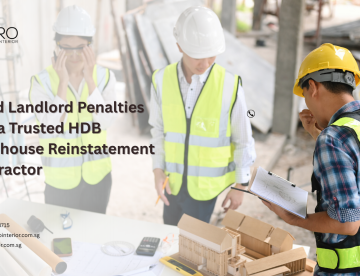Moving Office? Here’s How to Handle Reinstatement Without Drama & Hidden Costs

Introduction
Moving office in Singapore isn’t just about packing boxes and shifting your team to a new space. For most tenants, the real challenge is the reinstatement process — the obligation to return the office unit to its original condition as required by the landlord. This stage is often the source of stress, drama, and hidden costs that can escalate if not planned properly. From partition dismantling to electrical removal, floor restoration, and wall repairs — every detail of reinstatement must meet strict building standards. Many tenants end up facing extra charges because the work doesn’t meet the landlord’s specifications or the unit is handed over late. This article will help you understand how to complete your office reinstatement smoothly, without unexpected expenses. We provide a complete step-by-step guide on what you need to look out for and how to choose the right reinstatement contractor to ensure a fast, safe, and drama-free office relocation
What Is Reinstatement?
Reinstatement is the process of returning a leased unit to its original condition before renovation or fit-out, and it is a mandatory requirement in the Tenancy Agreement. This process typically includes removing partitions and cabling, dismantling additional electrical installations, restoring floors and walls, disposing of custom furniture, and cleaning the entire space. Some agreements also emphasize checking mechanical, electrical, and plumbing (MEP) systems to ensure all facilities are functioning properly. The goal is to allow the landlord to hand over the unit to the next tenant without delay. Careful planning and experienced contractors are essential to avoid additional costs or deductions from the security deposit due to non-compliance with reinstatement obligations.
Common Problems During Reinstatement
Many tenants face various challenges during the reinstatement process, such as not knowing the landlord’s reinstatement standards, starting the work too late, choosing the wrong contractor, or failing to anticipate hidden costs. To avoid these issues, there are several essential steps that should be taken from the very beginning of the planning process.
1.Read Your Lease Agreement Carefully (Don’t Skip the Technical Details!)
Most unexpected costs occur because tenants misunderstand their reinstatement obligations. To avoid this, pay close attention to several key points: requirements to restore the unit to its original condition, items that MUST be dismantled such as partitions, glass, gypsum walls, and flooring, items that MAY be left behind if approved by the landlord, the building’s M&E (Mechanical & Electrical) standards, permitted working hours for reinstatement work, and penalties for late handover. In addition, make sure to document the unit’s initial condition before renovation to have proof in case of disputes, and conduct regular inspections during the reinstatement process to ensure all work meets the required standards.
Money-saving tip: Ask the landlord or building management whether any “as-is” condition can be negotiated so that you don’t have to dismantle everything. Hiring experienced contractors and preparing a detailed budget can also help reduce the risk of extra costs and speed up the handover process.
2.Document the Space Before Renovation
Many reinstatement disputes arise due to disagreements over the original condition of the unit. To prevent this, it is recommended to take photos of all rooms before renovation, maintain the original building layout, and keep all approval emails or communication documents with the landlord. Additionally, record any minor changes made during renovation and document the condition of facilities such as electrical systems, plumbing, and M&E (Mechanical & Electrical). By taking these steps, when it comes time for reinstatement, you will know exactly what needs to be restored to its original condition. This not only helps avoid unnecessary work and extra costs but also speeds up the handover process and minimizes the risk of disputes with the landlord.
3.Prepare a Clear Scope of Work
Before hiring a contractor for reinstatement, it is advisable to create a detailed task list so that the progress of the work can be easily monitored and kept on schedule. The reinstatement scope should include dismantling partitions, removing built-in furniture, taking out carpeting or vinyl, restoring the grid ceiling to its original condition, rewiring electrical systems, servicing the AC and reinstating ducting, repainting to the original color, and performing final cleaning of the entire space. In addition, make sure to include inspections of M&E (Mechanical & Electrical) facilities, documenting the condition of floors and walls, and keeping records of each stage of the work. These steps help ensure that reinstatement is carried out correctly, avoid extra costs, and speed up the handover process to the landlord.
4. Plan Your Timeline Realistically
Last-minute reinstatement often increases costs due to factors such as overtime labor, higher disposal or truck fees, and mistakes caused by tight deadlines. To avoid this, it is recommended to create a well-planned schedule. For example, on Day -30, finalize the scope of work and obtain quotations from contractors; on Day -14, submit and complete all necessary permits and documentation; on Day -7, start the reinstatement works in stages; and on Day -1, conduct a final inspection to ensure all work meets the required standards. Additionally, maintain clear communication with contractors and building management, and regularly check the progress of the work. Careful planning not only helps reduce the risk of additional costs but also ensures the reinstatement process is completed on time and minimizes potential disputes with the landlord.
5. Use an Experienced Reinstatement Contractor
A general contractor may not fully understand Singapore’s building requirements, which can often result in work failing building inspections, penalties from the landlord, or tasks needing to be redone—leading to higher costs. Therefore, what you need is a contractor with specific experience in office reinstatement, familiar with building guidelines, and capable of working within tight schedules.
6. Request a Transparent and Detailed Quotation
Avoid contractors who offer vague “package prices.” Instead, ask for a full breakdown that includes the cost of partition dismantling per metre, electricalm reinstatement fees, disposal fees, permit and submission fees (if any), and labour costs. This helps you understand exactly what you are paying for and prevents any unexpected charges.
7. Conduct a Final Inspection With the Landlord
Before closing a reinstatement project, conduct a thorough inspection of the unit together with the landlord to ensure all work has been completed to standard. Check whether every area has been restored to its original condition, electrical systems have been properly reinstated, lighting and AC are functioning normally, and painting and finishing are clean and neat. Additionally, make sure all documentation is complete, including proof of material disposal, before-and-after photos, and records of materials used. If all work is approved, request a sign-off from the landlord to avoid any additional claims later. This step also helps maintain transparency, minimizes the risk of disputes, and speeds up the handover process to the next tenant.
8. Keep All Documentation After Completion
Documents such as work invoices, photos of the unit’s final condition, written approval from the landlord, and permit documents should be carefully preserved. These documents are crucial as official evidence in case of disputes or claims after the unit handover is completed. Additionally, keeping all these records helps you review the reinstatement process, ensure that all work has been carried out according to the agreement, and facilitates coordination with contractors or building management if any questions arise later. With complete documentation, the risk of conflicts or unexpected additional costs can be minimized, while providing peace of mind for both the tenant and the landlord.
Reinstatement Can Be Fast, Stress-Free & Transparent
With proper planning, a clear understanding of your tenancy obligations, and the support of an experienced reinstatement contractor, your office reinstatement can be completed quickly without drama or hidden costs. And if you want everything to run smoothly from start to finish, Zoro Interior is ready to assist with professional, transparent reinstatement services that meet Singapore’s building standards.
Your F&B Renovation Contractor:
- Quality workmanship without breaking the bank.
- Quick and hassle-free F&B renovation so you can focus on the important things while we work.
- Professional and personalised solutions for all your F&B renovation needs.
- Complete transparency from start to end - no hidden costs, no gimmicks.
Fill in this form now and get your free quote!




